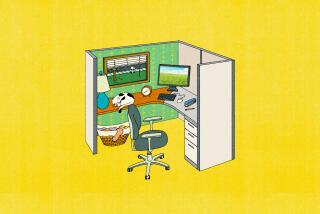At Home in the Flexible Workplace
MENLO PARK, Calif. — Amy Greene has a blatant disdain for her workplace. She shows up at the address on her business card only for mandatory meetings.
“I don’t like going into the office,” said Greene, a computer systems manager for Sun Microsystems Inc. “You just end up talking to people in the hallway. It’s unproductive.”
Such an attitude could get many employees in trouble. But Greene’s bosses applaud the 12-year Sun veteran for rejecting her assigned office in Newark across a traffic-choked bridge. She works instead at the company’s leafy campus closer to her Palo Alto home.
Scott McNealy, Sun’s chairman and chief executive, wants all 35,000 Sun employees to be prepared to abandon permanent desks in favor of flexible workstations and telecommuting. Proponents say it is prototype of how millions of Americans will work within a decade.
McNealy has long believed that companies could boost productivity and slash costs by eliminating regular desktop computers and giving workers access to centralized machines.
In the last year, he has preached the benefits of Sun’s “iWork” program at industry conferences and pitched clients on the virtues of the gadgets and software Sun has developed to connect employees. He’s transformed Sun into the most extreme example yet of workplace flexibility.
“Mobility is already a fact of life,” McNealy wrote on Sun’s Web site. “We’re simply responding to the current reality.”
Although critics, including some Sun employees, blast iWork as a morale-sapping gamble, the increased availability of high-speed Internet access at home has made telecommuting easier than ever. Almost 32 million people telecommuted full or part time in 2002, an increase of 2 million from 2000, according to research firm Cahners In-Stat/MicroDesign Resources.
Numerous banks, government agencies, universities and companies have purchased Sun’s “workforce mobility” technology.
IWork is based on the idea that few employees need file cabinets or bookshelves to store data that can reside on central computers, or servers. With secure access to servers, workers don’t need fragile laptops, desktop computers or even conventional desks.
Sun gives workers microchip-embedded “smart” cards and has installed computer monitors and card readers at thousands of workstations, even in the company cafeteria in Menlo Park.
IWorkers check e-mail and work with documents wherever they can find an access point -- at home, 93 flexible offices and nine “drop-in centers” in urban areas around the country.
Desks are reserved online on a first-come basis, and the phone system forwards calls to any location. The first 85 people who reserve seats in a San Francisco center, for instance, can avoid the 45-mile haul to Sun’s Santa Clara headquarters.
Sun began pushing flexible workstations in the mid-1990s, when executives determined that 35% of employees were telecommuting, visiting clients, on vacation or otherwise not using their desks at high-rent campuses in Santa Clara, Palo Alto and Menlo Park.
The company has spent $3 million per year since 1997 to convert 93 offices, eliminating 7,400 conventional desks.
Sun expanded iWork after the 2001 terrorist attacks, when many companies crafted emergency response plans to reduce reliance on a single building. More recently, employees in Asia moved to drop-in centers or worked from home to avoid high-rise buildings that were also home to cases of severe acute respiratory syndrome, or SARS.
Sun estimates that it saved $50 million last year and ultimately could see annual cost savings of $140 million.
But iWork doesn’t work for everyone, notably factory employees or product testers who have to toil in the same place each day.
And although employees enjoy the flexibility to work from home when their children are sick, several engineers said they missed the spontaneous brainstorms and “nerd bonding” over lunch or informal meetings.
Employees must request cubicles two days in advance and clear out when they leave. Forgotten umbrellas, briefcases and paperwork are often stolen or thrown away. The austerity of some of the beige, windowless offices -- bereft of plants, photos or personal touches -- would make Dilbert shudder.
Human relations experts worry that pushing iWork too far could erode interoffice relationships and further dent morale. Sun’s stock closed Friday at $4.30 a share, far from its all-time high of $64.66 in September 2000, and the company has announced it would slash 11% of its workforce, or 4,400 people, by mid-2003.
“Humans were designed to communicate and be affectionate and break bread together,” said David I. Levine, a professor of organizational behavior at UC Berkeley. “It’s going to take a long time to figure out how to break bread over the Internet.”






